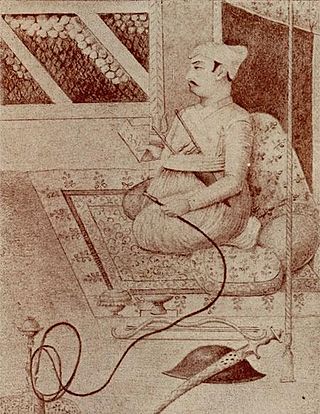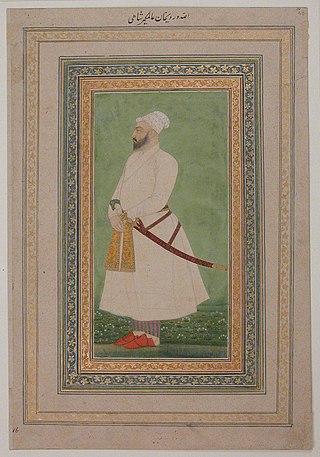Related Research Articles

A zamindar in the Indian subcontinent was an autonomous or semi-autonomous ruler of a province. The term itself came into use during the reign of Mughals and later the British had begun using it as a native synonym for “estate”. The term means landowner in Persian. They were typically hereditary, and held the right to collect tax on behalf of imperial courts or for military purposes.

Murshidabad is a historical city in the Indian state of West Bengal. It is located on the eastern bank of the Bhagirathi River, a distributary of the Ganges. It forms part of the Murshidabad district.

The Battle of Buxar was fought between 22 and 23 October 1764, between the forces under the command of the British East India Company, led by Hector Munro, and the combined armies of Mir Qasim, Nawab of Bengal till 1764; the Nawab of Awadh, Shuja-ud-Daula; and the Mughal Emperor, Shah Alam II. The battle was fought at Buxar, a "strong fortified town" within the territory of Bihar, located on the banks of the Gangas river about 130 kilometres (81 mi) west of Patna; it was a challenging victory for the British East India Company. The war was brought to an end by the Treaty of Allahabad in 1765. The defeated Indian rulers were forced to sign this treaty, granting the East India Company diwani rights, which allowed them to collect revenue and administer the territories of Bengal, Bihar, and Orissa. This gave the company immense economic and administrative control, enabling them to exploit the resources of the region for their own benefit.

The Nawab of Bengal was the hereditary ruler of Bengal Subah in Mughal Empire. In the early 18th-century, the Nawab of Bengal was the de facto independent ruler of the three regions of Bengal, Bihar, and Orissa which constitute the modern-day sovereign country of Bangladesh and the Indian states of West Bengal, Bihar and Orissa. They are often referred to as the Nawab of Bengal, Bihar and Orissa. The Nawabs were based in Murshidabad which was centrally located within Bengal, Bihar, and Odisha. Their chief, a former prime minister, became the first Nawab. The Nawabs continued to issue coins in the name of the Mughal Emperor, but for all practical purposes, the Nawabs governed as independent monarchs. Bengal continued to contribute the largest share of funds to the imperial treasury in Delhi. The Nawabs, backed by bankers such as the Jagat Seth, became the financial backbone of the Mughal court. During the 18th century, the Nawabs of Bengal were among the wealthiest rulers in the world.

The Great Bengal famine of 1770 was a famine that struck Bengal and Bihar between 1769 and 1770 and affected some 30 million people. It occurred during a period of dual governance in Bengal. This existed after the East India Company had been granted the diwani, or the right to collect revenue, in Bengal by the Mughal emperor in Delhi, but before it had wrested the nizamat, or control of civil administration, which continued to lie with the Mughal governor, the Nawab of Bengal Nazm ud Daula (1765-72).

Mir Syed Jafar Ali Khan Bahadur was a commander-in-chief or military general who reigned as the first dependent Nawab of Bengal of the British East India Company. His reign has been considered by many historians as the start of the expansion of British control of the Indian subcontinent in Indian history and a key step in the eventual British domination of vast areas of pre-partition India.

Mir Qasim was the Nawab of Bengal from 1760 to 1763. He was installed as Nawab with the support of the British East India Company, replacing Mir Jafar, his father-in-law, who had himself been supported earlier by the East India Company after his role in winning the Battle of Plassey for the British. However, Mir Jafar eventually ran into disputes with the East India Company and attempted to form an alliance with the Dutch East India Company instead. The British eventually defeated the Dutch at Chinsura and overthrew Mir Jafar, replacing him with Mir Qasim. Qasim later fell out with the British and fought against them at Buxar. His defeat has been suggested as a key reason in the British becoming the dominant power in large parts of North and East India.

Bihari Muslims are adherents of Islam who identify linguistically, culturally, and genealogically as Biharis. They are geographically native to the region comprising the Bihar state of India, although there are significantly large communities of Bihari Muslims living elsewhere in the Indian subcontinent due to the Partition of British India in 1947, which prompted the community to migrate en masse from Bihar to East Pakistan.

Alivardi Khan was the Nawab of Bengal from 1740 to 1756. He toppled the Nasiri dynasty of Nawabs by defeating Sarfaraz Khan in 1740 and assumed power himself.

Shuja-ud-Din Muhammad Khan was the Nawab of Bengal. He married Zainab un-nisa Begum and Azmat un-nisa Begum, the daughters of Murshid Quli Khan by Nasiri Banu Begum. Shuja-ud-Din's third wife was Durdana Begum Sahiba. After the death of his father-in-law on 30 June 1727, he ascended to the Masnad (throne) of the Nawab.
The Maratha invasions of Bengal (1741–1751), also known as the Maratha expeditions in Bengal, were the frequent invasions by the Maratha forces in the Bengal Subah, after their successful campaign in the Carnatic region at the Battle of Trichinopoly. The leader of the expedition was Maratha Maharaja Raghoji Bhonsle of Nagpur. The Marathas invaded Bengal five times from August 1741 to May 1751, which caused widespread economic losses in the Bengal Subah.
The Kulhaiya Sheikh is a Muslim community found in the northeastern part of the Indian state of Bihar as well as the terai region of south-east Nepal.

The Zamindars of Bengal were zamindars of the Bengal region of the Indian subcontinent. They governed an ancient system of land ownership.

The Bengal Subah, also referred to as Mughal Bengal, was the largest subdivision of Mughal India encompassing much of the Bengal region, which includes modern-day Bangladesh and the Indian state of West Bengal, and some regions from the Indian states of Bihar, Jharkhand, Odisha between the 16th and 18th centuries. The state was established following the dissolution of the Bengal Sultanate, a major trading nation in the world, when the region was absorbed into the Mughal Empire. Bengal was the wealthiest region in the Indian subcontinent.

Mehar un-Nisa Begum, better known as Ghaseti Begum, was the eldest daughter of Alivardi Khan, Nawab of Bengal, Bihar and Orissa during 1740–1756.

The Greater Sylhet region predominantly included the Sylhet Division in Bangladesh, and Karimganj district in Assam, India. The history of the Sylhet region begins with the existence of expanded commercial centres in the area that is now Sylhet City. Historically known as Srihatta and Shilhatta, it was ruled by the Buddhist and Hindu kingdoms of Harikela and Kamarupa before passing to the control of the Sena and Deva dynasties in the early medieval period. After the fall of these two Hindu principalities, the region became home to many more independent petty kingdoms such as Jaintia, Gour, Laur, and later Taraf, Pratapgarh, Jagannathpur, Chandrapur and Ita. After the Conquest of Sylhet in the 14th century, the region was absorbed into Shamsuddin Firoz Shah's independent principality based in Lakhnauti, Western Bengal. It was then successively ruled by the Muslim sultanates of Delhi and the Bengal Sultanate before collapsing into Muslim petty kingdoms, mostly ruled by Afghan chieftains, after the fall of the Karrani dynasty in 1576. Described as Bengal's Wild East, the Mughals struggled in defeating the chieftains of Sylhet. After the defeat of Khwaja Usman, their most formidable opponent, the area finally came under Mughal rule in 1612. Sylhet emerged as the Mughals' most significant imperial outpost in the east and its importance remained as such throughout the seventeenth century. After the Mughals, the British Empire ruled the region for over 180 years until the independence of Pakistan and India. There was a complete list of the different amils who governed Sylhet which was recorded in the office of the Qanungoh of Sylhet. However, most complete copies have been lost or destroyed. Dates from letters and seal traces show evidence that the amils were constantly changed. In 1947, when a referendum was held, Sylhet decided to join the Pakistani province of East Bengal. However, when the Radcliffe Line was drawn up, Karimganj district of Barak Valley was given to India by the commission after being pleaded by Abdul Matlib Mazumdar's delegation. Throughout the History of Sylhet, raids and invasions were also common from neighbouring kingdoms as well as tribes such as the Khasis and Kukis.

The Zamindars of Bihar were the autonomous and semi-autonomous rulers and administrators of the Mughal subah of Bihar and later during British rule. The zamindars of Bihar were numerous and could be divided into small, medium and large depending on how much land they controlled. Within Bihar, the zamindars had both economic and military power. Each zamindari would have their own standing army which was typically composed of their own clansmen.
The Mayi were a clan of Muslim Rajputs which controlled the Narhat-Samai chieftaincy in modern-day Nawada district of Bihar.

The Gidhaur Chieftaincy was a principality which controlled parts of South Bihar for much of the medieval period in India. The chieftaincy was named after the town of Gidhaur in Jamui district but its territory extended into the wider region.
Maharaja Beni Bahadur was an administrator, minister, soldier & househelp in the courts of the Nawabs of Awadh from 1733 / 1734 to at least 1798 & at most 1814. He was most notable for his rapid rise to power, industry and charity.
References
- ↑ Abdul Majed Khan (3 December 2007). The Transition in Bengal, 1756-75: A Study of Saiyid Muhammad Reza Khan. Cambridge University Press. pp. 184–. ISBN 978-0-521-04982-5.
- ↑ P. J. Marshall (2 November 2006). Bengal: The British Bridgehead: Eastern India 1740-1828. Cambridge University Press. p. 50. ISBN 978-0-521-02822-6.
- ↑ Kumkum Chatterjee (1996). Merchants, Politics, and Society in Early Modern India: Bihar, 1733-1820. BRILL. pp. 88–. ISBN 90-04-10303-1.
- 1 2 3 Anwarul Haque (1995). "Saif Khan as a Faujdar of Purnia". Proceedings of the Indian History Congress. 56: 240–242. JSTOR 44158625.
- 1 2 3 Pranab Chandra Roy Choudhury (1968). Purnea: Bihar District Gazetteers. Superintendent, Secretariat Press, Bihar. pp. 68-75.
- ↑ Nitish K. Sengupta (2011). Land of Two Rivers: A History of Bengal from the Mahabharata to Mujib. Penguin Books India. p. 164. ISBN 978-0-14-341678-4.
- 1 2 Julia Keay (30 August 2014). Farzana: The Woman Who Saved an Empire. I.B.Tauris. pp. 44–. ISBN 978-1-78453-055-6.
- 1 2 Imanshing Chemjong (15 April 2014). Kirat History and Culture. Amar Nembang. pp. 82–83. GGKEY:PP03Y9PZZBD.